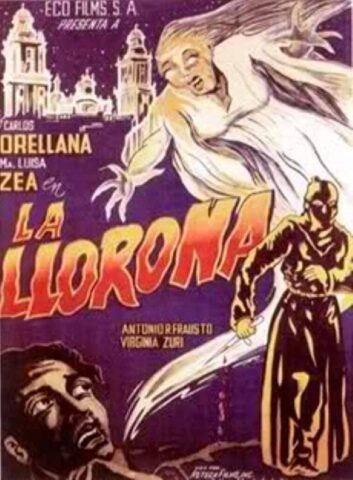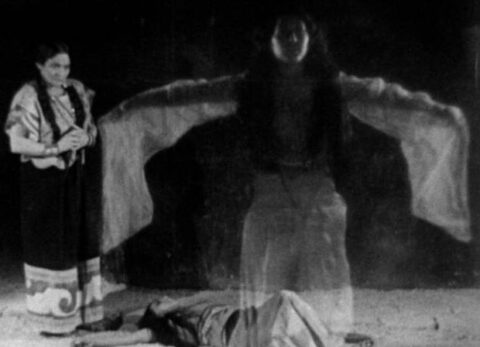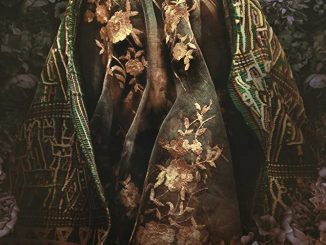La Llorona (1933)
Directed by: Ramón Peón
Written by: A. Guzman Aguilera, Carlos Noriega Hope, Fernando de Fuentes
Starring: Adriana Lamar, Carlos Orellana, Ramón Pereda, Virginia Zurí
AKA THE CRYING WOMAN
MEXICO
AVAILABLE ON BLU-RAY from INDICATOR
RUNNING TIME: 70 mins
REVIEWED BY: Dr Lenera

In Mexico City, a man walking down a street is seemingly killed by fright after hearing the eerie sound of a wailing woman. Dr. Ricardo di Acuna insists it was a heart attack and poo-poos superstitious beliefs in front of his students. However, upon visiting his father in law Don Fernando de Moncado, he finds a man who’s very worried about his young grandson Juanito. It seems that there’s a skeleton in the family closet which goes all the way back to the times of the Conquistadors; a tale of illegitimacy, suicide and a curse reaching out from beyond the grave that is supposed to cause the oldest son of each generation to die on their fourth birthday. And there’s a robed, hooded intruder stalking around their house….

It’s perhaps small wonder that there have been a fair few film versions of this Mexico folktale, a tale that’s tragic, frightening and with a strong sociological aspect, though whether the latter is progressive or regressive is probably something that scholars debate about and something that I may go onto in this review if I feel so inclined or if I feel that it’s important in a look at this first movie adaptation. The story is generally associated with Mexico, though variations exist in the mythology of other cultures. If you know your Greek mythology, you cannot help but think of the story of the demigoddess Lamia. Zeus, the king of the gods, and a randy bugger who was always cheating on his wife Hera, had several children with Lamia. When Hera found out, she killed all the children. Driven mad by this awful event, Lamia went around murdering other kids. The Mexican legend itself has many variations and was in the Aztec culture before the Spaniards arrived, though the most famous version involves a poor indigenous woman who marries or who has a relationship with a rich man who’s often a Conquistador. In a fit of rage over him abandoning her, cheating on her or taking her children away, she either drowns the child or children she bore, or fails to stop them from drowning. Consumed by guilt, she drowns herself as well but is unable to enter the afterlife and is stuck in purgatory to roam this earth until she finds her children, equipped with a terrifying cry which seems nearby when she’s far away and seems far away when she’s nearby. Often told to stop kids from going out after dark or wondering off on their own, La Llarona is still surprisingly obscure in the UK even though the films still come out every now and again, the most recent offerings reviewed by yours truly and David S. Smith.
Unlike most of my co-writers for this website, it’s often old movies that “get my horror juices flowing”, to use a term that Ross Hughes employs, so I was most interested in Indicator releasing two rarely seen Mexican chillers from the 1930’s, both thought lost for many decades until shoddy copies from Mexican TV turned up on YouTube. I could have watched those, but then I didn’t even know of their existence until a few weeks ago. This film started off a mini horror boom in a country that’s much better known for a second and much longer lasting horror boom that started over two decades later with masked wrestlers, mad scientists and Aztec mummies. I’ve not seen any of those either. Two many movies not enough time, at least if you want a social life. Anyway, we’re here to talk about this one, and it’s a very intriguing work indeed even if not all of its many ingredients come off. I’d imagine that many watching it for the first time would expect something akin to the early Universal horrors, and there are times when it is, though for the most part it lacks their wonderful atmosphere. It does, though, have a hell of a lot of ambition for something so short [the pics I’ve included don’t do it justice but there aren’t that many around]. Introductory text tells us that we’re watching “a modern version of the popular legend”, though we’re only doing that for around half the picture’s running time, and a rather changed one, missing some of the usual aspects such as water. The rest of the time is spent telling the two most famous early incarnations of the legend, taking the form of one very extended flashback and one short one. It’s an unusual structure that you probably wouldn’t have seen in an American film of the time, though I do keep thinking of how the original cut of the 1932 The Mummy had flashback scenes of some of its heroine’s reincarnations in different times. Nor would you have probably seen certain things that happen depicted on American screens, not to mention an anti-colonial element. Things don’t entirely hang together, but interest level remains high in a film which is surprisingly unpredictable and which even seems to change genres a few times.
We begin in a darkened street where a man, probably drunk judging by his staggering, hears a wail – and by god they made the wail blood curdling in this movie, it sent chills down my spine the first time I heard it! He collapses dead there and then, a cut to the the fingers of one of his hands moving a surprising and grim detail. We transition to the same hand, now definitely immobile, on a mortuary table, in the first of many nice, well worked out transitions director Ramon Perez gives us to enjoy and link scenes together. Our sceptical hero Ricardo pronounces the cause of death to be suicide, but those around him don’t seem to be too sure, prompting a debate over the contrast between the rational and the supernatural that would benefit from being longer. Cut again to a high angle shot of six tables put in a circle to form one, then lots of slow pans around children sitting there eating that may be long for some, though uneasiness begins when the valet of the house, the somewhat mentally challenged Mario, also sits there to nervously make up twelve until the birthday boy Juanito finally shows up. We’re in the lavish abode of Don Fernando, who tells Mario to know his place. It’s an important little moment, because one of the major themes throughout is people rightly or wrongly having to know their place. Staying in the house are Fernando’s son-in-law Ricardo and his wife Anna Maria, Juanito being their son. There’s a cute moment where Juanito says that he wants to turn four all over again. In the library, Fernando tells Ricardo that both his son and his brother disappeared before being found dead having been stabbed in the face, and thinks that Juanito could be next. After all “the blood of the Mocardo and Cortez families runs through his veins”. Indeed somebody in a black robe and hood has somehow got into the house and is not just lurking around but might just be capable of murder.

Fernando recites from a book the story of nobleman Rodrigo de Cortes and Ana Xiconténcatl, an Aztec lady who he took to Mexico City to live with and to bear him a child. However, unbeknownst to her, he also has a fiancee. Because she’s of higher social standing, he wants to go ahead with the wedding and, even though their child is now nearly four, will not name the boy he’s had with Ana, which is basically not properly acknowledging him, though he keeps promising to Ana that he will do so. Ana has another admirer, Captain Don Diego de Acuña who’s in love with her, though he can’t stop himself from coming to Cortez’s aid when dueling with a gang after some gold he has. Ana and Diego are soon to make things bad for Cortez, but Ana is becoming mentally ill. This sad tale has some power and one genuine shock that we don’t expect to see, plus a cheeky cut away from a sword fight which we never know who won yet we don’t care much because what’s also happening is more interesting. But Ana’s transition to a lunatic is glossed over, and the idea that this is what started off this curse is later muddied when Ricardo reads from another book another version of the legend, via a really odd transition of characters walking round in circles. Taking place even earlier than the other, it involves no less than Hernando Cortez, the notorious brutal conquistador himself, and Marina/La Malinche, the real-life Aztec woman who welcomed him. Seeing as it’s brief with narration doing much of the work, it fails to have much of an impact and the film might have been better off without its inclusion and instead given some more moments of characterisation to some of the modern characters which would have made us care about them a bit more – but then the script by Noriega Hope and Fernando de Fuentes does seem like it’s been truncated. Still, the final quarter mostly works and it’s real fun seeing Mexico do what appears to be no less than a proto giallo but which is clearly a spin on the haunted house mysteries such as The Cat And The Canary that were so popular in the States at the time, though lacking their usual humorous elements.
Performances are amazingly restrained, actually more naturalistic and less stagy than what you would have seen in Hollywood circa 1933, though it’s Carlos Orellana as the very odd Mario who makes the strongest impression. He’s given nice little moments which make us look forward to his next appearance, and we want to cheer when he contributes immensely to saving the day. Perhaps unsurprisingly, there aren’t really a lot of horror scenes, but the shots of ghosts coming out of dead bodies to fly across the air are surprisingly effective [sometimes those old supposedly primitive special effects are still just fine], and there’s a very creepy moment indeed where the killer comes out of a secret door, the black of his garb merging with the black of his immediate surroundings so that we only see his eyes, to stab somebody. La Llorona was shown in Mexican cinemas in the US. The MPAA of 1933 was a bit more lenient than the one of 1934 when things got really strict, so an unmarried couple living together with a child and two shots of blood may have been okay, but it’s doubtful that viewers in America would have been allowed to see infanticide depicted on camera [if unexplicitly], so it was probably cut. And the MPAA of 1934 would have definitely had kittens about the suicide element. Of course the La Llorona tale is largely about guilt, but it’s also about a woman’s place in society – but does it reinforce patriarchal expectations of women, especially in having them being defined as mothers and having to know their place, or support rebelling against a male-controlled system, the two men in the flashbacks being highly unpleasant? Certainly the La Llorona character always provokes sympathy as well as fear. I guess it’s a bit of both, which certainly comes across in this particular movie, yet you wouldn’t see anything even slightly as progressive in this area in an American-made film of the time, not to mention a negative depiction of people like the Conquistadors, who we know were truly horrible yet who also were white so would have naturally been favoured much more by most screenwriters.
Said screenwriters Hope and Fuentes stumble at times, including a weird moment where Ricardo pointlessly lies about something very awful he’s discovered, though I guess that they may not have been responsible for things such as a few closeups of an extremely minor character which are presumably there to make us think that he’s the killer. Likewise the lengthy church scene where the camera pans and pans along rows of people; it may bore some though I found it enticingly odd, and the camera of Guillermo Baqueriza [who also edited] is more mobile than was the norm for the period. The sound recording of Mexican films really was very primitive though. In fact they didn’t even have the technology to have dialogue and music at the time, while some sound effects are quiet and some aren’t heard at all. Max Urban’s score is full of different themes and motifs though doesn’t always seem appropriate and certainly doesn’t enhance the terror element. The restoration by Indicator, who’ve released this on Blu-ray, could only do so much, picture and sound still not being great, but kudos to them for bringing it out anyway. It doesn’t succeed in reaching as high as it aims, but it’s still a rather rich and generally involving effort. And you’ll be hearing from me about some of the successive versions.
Rating: 













Be the first to comment